The term “value” is probably the most overused word in business today.
Everyone claims to offer value and everyone claims their product offers the most. But, more often than not, when this term is used, it’s referring to absolute value. In other words, what you get for your money.
Customers don’t care about absolute value because it has no real substance. It’s difficult if not impossible to define apart from price, so that’s where they tend to focus. For all intents and purposes, when a customer wants to know the “value” of their purchase, they look at the price tag, and compare based on that.
What is differential value?
Differential value is the economic expression of the unique portion of your value proposition. It is your next best alternative. As such, differential value adds knowledge and context to the concept of “value”.
It’s not just a nebulous description of what the customer gets for their money. Instead, it describes how and why the customer can only obtain this particular value by purchasing this particular product. It provides an easily identifiable means of comparing products that doesn’t rely strictly on price.
And that’s a truly powerful tool to have in your toolbox if you’re a salesperson trying to sell products in a highly competitive market.
To determine your product’s differential value, three components must be brought together:
- You must understand the customer’s frame of reference, or what they consider to be their next best alternative.
- You must be able to clearly articulate how and why your product is unique and better than that alternative.
- You must be able to connect that differential value to your price and any pricing action you wish to take.
With these three components in place, you’re in a prime position to grab market share simply by explaining why your customers are making a smart decision buying your product.
How do you know which “value” you’re using?
As highlighted earlier, everyone uses “value” in their marketing and sales pitches. You do too. But are you using the effectively useless absolute value? Or are you using the powerful differential value in your sales conversations?
If any of the following sound familiar to you, you’re probably still stuck on absolute value:
- You’re constantly discounting to maintain sales volume
- You’re really not sure how to answer the question, “why do your customers buy from you?”
- Customers tend to ignore any attempt by you to communicate your product’s value.
These are signs that your marketing and sales teams are unclear about what makes your products better than the competition, and your customers have no idea. At best, they’re focusing on price when making purchasing decisions, and at worst, they view your product as a commodity.
How to shift from absolute to differential value
To adjust the equation and move to a much more powerful position of communicating differential value, you need to apply yourself to identifying and fully understanding the three components of differential value mentioned above.
- First, take a deep, long look at your current value proposition from the customer’s perspective: Why do your customers buy from you?
- Second, learn everything you can about your customer’s next best alternative: What does the competition offer and why do customers choose them rather than you?
- Finally, quantify the differences in economic terms: How will your customers actually lose money by choosing your competitor’s product over yours?
If you can accomplish those three goals, you will have effectively moved the focus from price to differential value, separating yourself from your competition in a clear and explainable way that your customers will be able to understand.
Customers are largely indifferent to absolute value. But they perk up when introduced to differential value. This provides clear sales leverage, helping salespeople communicate why customers should buy from you. It improves the work your salespeople are doing because they can finally differentiate themselves from competitive salespeople. And, it improves the overall marketing message by offering more specific and quantifiable information for marketing to spread.
If you’d like to learn more about making the switch to a differential value proposition, read our white paper on choosing value over cost.


